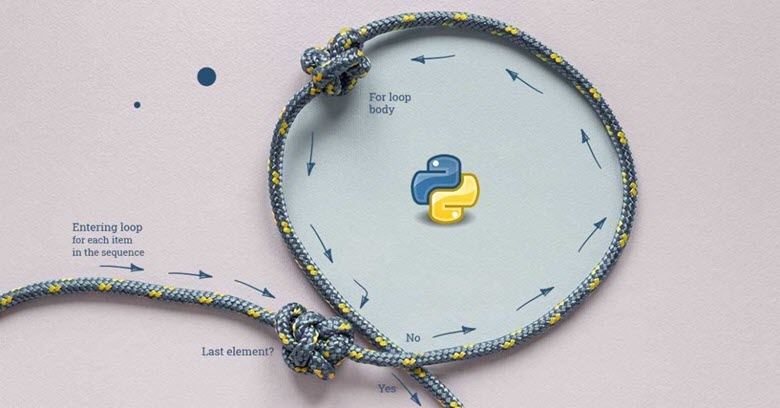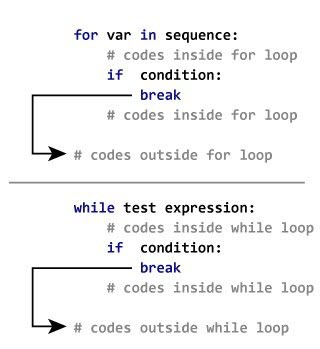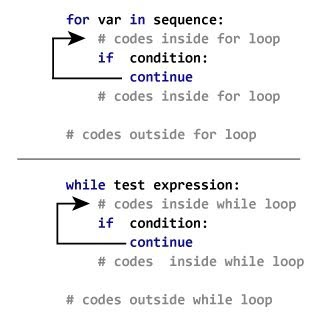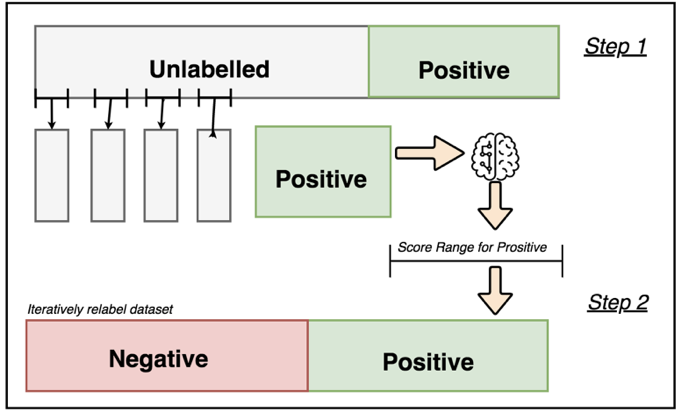文章内容如有错误或排版问题,请提交反馈,非常感谢!
Python中可以使用两种类型的循环:for循环和while循环。您可以将它们用于重复任务。因此,重复性任务将自动发生,使流程更加高效。不幸的是,您的循环可能会遇到一些问题。有时,您的程序可能会遇到问题,需要它跳过循环的一部分或完全退出循环。或者你需要它来忽略影响程序的外部因素。如果这是要添加到程序中的内容,则需要使用break、continue和pass语句。

break
break语句负责终止使用它的循环。如果在嵌套循环中使用break语句,则当前循环将终止,并且流将继续执行循环后面的代码。
break语句的流程图:

流程图中涉及的步骤:
- 步骤1)循环执行开始。
- 步骤2)如果循环条件为true,它将执行步骤2,其中将执行循环体。
- 步骤3)如果循环的主体具有break语句,则循环将退出并转至步骤6。
- 步骤4)循环条件执行并完成后,将进入步骤4中的下一个迭代。
- 步骤5)如果循环条件为false,它将退出循环并转至步骤6。
- 步骤6)循环结束。

while循环
my_list = ['Siya', 'Tiya', 'Guru', 'Daksh', 'Riya', 'Guru']
i = 0
while True:
print(my_list[i])
if my_list[i] == 'Guru':
print('Found the name Guru')
break
print('After break statement')
i += 1
print('After while-loop exit')
输出:
Siya Tiya Guru Found name Guru After while-loop exit
当遇到break时,直接跳出while循环。
for循环
my_list = ['Siya', 'Tiya', 'Guru', 'Daksh', 'Riya', 'Guru']
for i in range(len(my_list)):
print(my_list[i])
if my_list[i] == 'Guru':
print('Found the name Guru')
break
print('After break statement')
print('Loop is Terminated')
输出内容:
Siya Tiya Guru Found the name Guru Loop is Terminated
当遇到break时,直接跳出for循环。
多层for循环
for i in range(4):
for j in range(4):
if j == 2:
break
print("The number is", i, j);
输出:
The number is 0 0 The number is 0 1 The number is 1 0 The number is 1 1 The number is 2 0 The number is 2 1 The number is 3 0 The number is 3 1
Break只会跳出一层。
continue
当continue语句在循环结构中执行时,并不会退出循环结构,而是立即结束本次循环,重新开始下一轮循环,也就是说,跳过循环体中在continue语句之后的所有语句,继续下一轮循环。
continue语句的流程图:

流程图中涉及的步骤:
- 步骤1)循环执行开始。
- 步骤2)循环内的代码执行将完成。如果循环中有一个continue语句,控件将返回到步骤4,即下一次迭代循环的开始。
- 步骤3)循环内的代码执行将完成。
- 步骤4)如果有一个continue语句,或者在主体内循环执行完成,它将调用下一个迭代。
- 步骤5)循环执行完成后,循环将退出并转至步骤7。
- 步骤6)如果步骤1中的循环条件失败,它将退出循环并转到步骤7。
- 步骤7)循环结束。

while循环
i = 0
while i <= 10:
if i == 7:
i += 1
continue
print("The Number is:", i)
i += 1
输出:
The Number is: 0 The Number is: 1 The Number is: 2 The Number is: 3 The Number is: 4 The Number is: 5 The Number is: 6 The Number is: 8 The Number is: 9 The Number is: 10
for循环
for i in range(10):
if i == 7:
continue
print("The Number is:", i)
输出:
The Number is: 0 The Number is: 1 The Number is: 2 The Number is: 3 The Number is: 4 The Number is: 5 The Number is: 6 The Number is: 8 The Number is: 9
多层for循环
for i in range(4):
for j in range(4):
if j == 2:
continue
print("The number is", i, j)
The number is 00 The number is 01 The number is 03 The number is 10 The number is 11 The number is 13 The number is 20 The number is 21 The number is 23 The number is 30 The number is 31 The number is 33
pass
Python pass语句在循环、函数、类和if语句中用作占位符,不做任何事情,是一个空操作。
使用场景:假设你有一个函数或者一个空的类。您计划在将来编写代码。如果Python解释器遇到一个空的对象,它将抛出一个错误。pass语句可以在函数体或类体内部使用。在执行过程中,当解释器遇到pass语句时,会忽略并继续执行,而不会给出任何错误。



